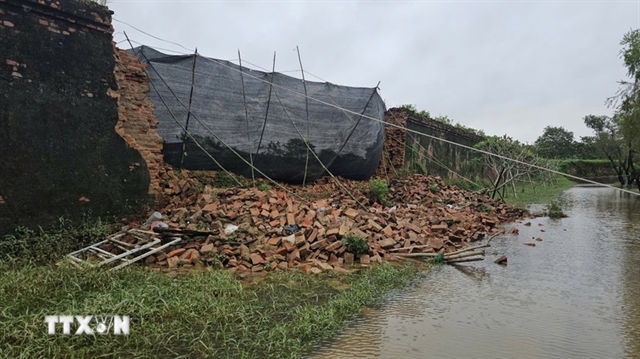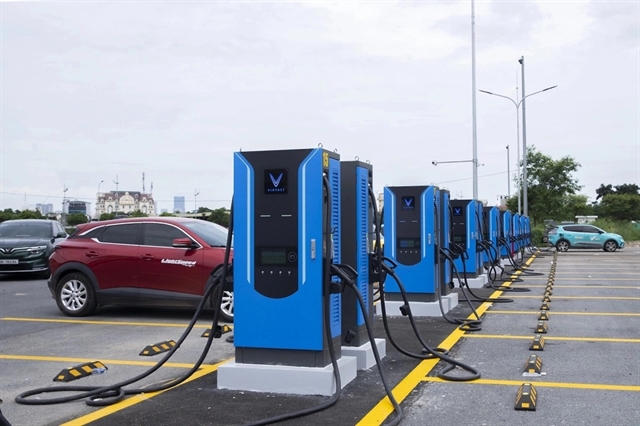 Society
Society

.jpg) |
| Hà Nội's streets shrouded in haze from pollution. — VNA/VNS Photo |
HÀ NỘI — When traffic peaks and smog fills the sky, Hà Nội’s need for clean air becomes more urgent than ever.
To address this, the city is planning a significant shift from gasoline-powered motorbikes to electric.
Air pollution from traffic in Hà Nội fluctuates noticeably depending on the time of day and type of vehicle, according to a joint study by scientists from the University of Science (Vietnam National University, Hà Nội) and researchers from the United Kingdom.
The findings show that motorbikes are the primary source of emissions during the day, while at night, heavy-duty trucks take over as the main contributors.
According to Associate Professor. Dr. Hoàng Anh Lê from Vietnam National University, most motorbikes lack emission filters, releasing raw exhaust. Combined with slow traffic, averaging just 35km per hour, this leads to higher fuel use and more pollution.
Hà Nội’s Ring Road 1, dense with intersections and snarled traffic, was identified as the pollution hotspot. Meanwhile, Ring Roads 2 and 3 disperse pollutants more widely, thanks to more open landscapes.
Nguyễn Hoàng Ánh, acting head of the Environmental Quality Management Division under the Department of Environment, Ministry of Agriculture and Environment, echoed this view, adding that traffic, when combined with weather conditions, is a key driver of pollution.
However, she stressed that accurately identifying the sources requires a full emissions inventory, something Việt Nam has yet to complete.
Speaking at the recent forum 'Converting gas scooters to electric: Leaving no one behind', she said Hà Nội and HCM City experienced an unprecedented clearing of skies during the COVID-19 lockdowns.
But with the return of economic activities, those crystal-clear days have become a rarity. Official measurements attribute over 60 per cent of Hà Nội’s air pollution to traffic.
However, national estimates suggest that, while transport emissions account for 38 per cent, that figure breaks down to 15 per cent from exhaust fumes and 23 per cent from vehicle-generated dust, making it the single largest contributor to urban haze.
Another 29 per cent comes from construction dust (17–18 per cent) and burning of agricultural residues and tires (15–16 per cent), data meticulously compiled in a report submitted to the Prime Minister’s office.
Yet, as she emphasised, these numbers are only a starting point: “Without an emissions inventory, we can’t pinpoint sources precisely. But our vehicle emissions, combined with Hanoi’s weather patterns, are clearly the core issue.”
Hà Nội consistently records higher peak pollution than HCM City. And over recent months, the worst air quality has shifted from the early morning rush hours (6am–8am) to a mid-morning window of 9am–12pm.
“It’s the interplay of heavy traffic and atmospheric conditions,” Ánh said.
On July 12, the Prime Minister issued a directive calling for more substantial nationwide efforts to reduce vehicle emissions, especially from motorbikes.
Although Việt Nam has around 70 million motorbikes, current emission standards apply only to new ones. Most older vehicles remain unchecked, according to Nguyễn Đông Phong from the Motor Vehicle Emission Testing Centre under the Vietnam Register.
The policy push prioritises inner-city districts, starting with Hà Nội’s Ring Road 1. Authorities estimate that around 450,000 gas-powered scooters operate daily in the nine wards, which house 600,000 residents.
To kick-start the transition, local authorities must survey users, collect data and craft supportive frameworks, from infrastructure readiness to incentives and public outreach.
 |
| Emissions from old, dilapidated motorbikes. — Photo suckhoedoisong.vn |
Building the electric lifeline
Today, Hà Nội counts only about 1,000 charging poles, located across public transport hubs, car charging stations and areas with high e-bike usage.
Vice Chairman Dương Đức Tuấn has ordered a comprehensive inventory of parking lots and public spaces for the deployment of chargers. In older apartment buildings, officials urge upgrades to electrical systems while cautioning against using basements for charging due to safety risks.
Lưu Thị Thanh Chi of Hà Nội’s Department of Natural Resources said the city isn’t banning cars outright, but will increase circulation and parking fees to nudge people toward public transit. By 2030, all city buses are slated to transition to electric or clean-gas models.
Meanwhile, construction sites will face stricter oversight. Cameras and fines will target trucks that spill dust, further curbing particulate pollution. Low-emission zones are already being piloted in areas such as Hoàn Kiếm and Cửa Nam, with plans to expand into Ring Road 2 areas.
Public transport is also gearing up. Two metro lines, Cát Linh–Hà Đông (since 2021) and Nhổn–Hà Nội Station (since 2024), have carried over 42 million passengers, with ridership up 9.5 per cent in 2023 and 14 per cent in 2024.
The Hà Nội Urban Railways Company is working to integrate minibuses, especially electric ones, better connecting metro exits to communities.
Officials are also exploring relaxed regulations for e‑vehicles under 30km per hour in the inner city, acknowledging their potential as last-mile solutions. Parallel efforts to install more chargers and battery-swap points underscore a shift toward a digital, green mobility ecosystem.
Professor Nguyễn Đức Lượng of the University of Civil Engineering argued that Việt Nam can take inspiration from other countries.
South Korea has targeted an all-electric new car fleet by 2030, fostering battery production and fast-charging networks. Japan offers tax breaks for EV and hybrid buyers. India incentivises e-scooters and local battery production. Thailand aims for a 30 per cent EV market share by 2030. And Indonesia is working to electrify 6 million e-bikes this year, with a target of 13 million by 2030.
From government subsidies to public-private partnerships and smart infrastructure integration, these cases offer a playbook, though each must be tailored to Việt Nam’s unique needs.
Policy meets people
Dr Hoàng Dương Tùng of the Việt Nam Clean Air Network highlighted a critical point: opportunity alone won't lead to change without clear roadmaps and concrete policies.
 |
| An electric car charging station by VinFast. — Photo baochinhphu.vn |
Hà Nội is well-equipped with the necessary conditions and solutions to lead the transition to electric vehicles, particularly benefiting from the advantages under the Capital Law. As such, the city must take the lead and serve as a model for other provinces, implementing all feasible measures by 2025 and 2026 without delay.
To meet these targets, effective public communication is crucial. Current outreach efforts have left many residents uninformed or confused about policies. Clear and comprehensive communication is essential to ease public concerns and foster trust.
"Residents are eager for detailed, concrete plans from the authorities that provide reassurance and transparency. Such plans should draw on international experience while being tailored to local realities," Tùng said.
"This challenge requires coordinated action from relevant ministries, not Hà Nội alone."
Electric vehicles offer clear benefits, including lower costs compared to petrol scooters in the same category, zero local emissions, remote monitoring, anti-theft protection, GPS tracking, and lower maintenance expenses.
The capital city’s air pollution goals must also align with climate objectives, extending beyond motorbikes to include private cars through policies aimed at reducing personal vehicle use. Timely regulations on charging stations and battery swapping are also essential to support businesses and accelerate adoption.
To ensure a smooth transition from gas to electric motorbikes, Dr Hoàng Anh Lê said the focus must go beyond policy. Technical and social factors, particularly safety and user convenience, are equally critical.
Instead of developing a vast network of home charging stations, Dr. Lê supported a battery-swapping model. He suggested that manufacturers adapt battery designs to allow quick, hassle-free replacements, much like a standard petrol refill today.
He also proposed transforming existing fuel stations into charging or battery-swap points. This would lower infrastructure costs and offer safer, more centralised energy distribution, using locations that are already integrated into the city’s transport system. — VNS




